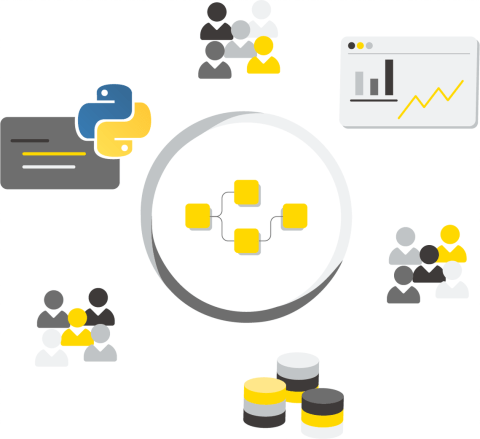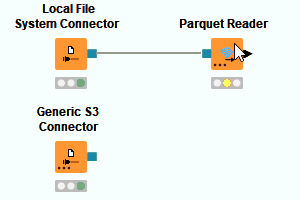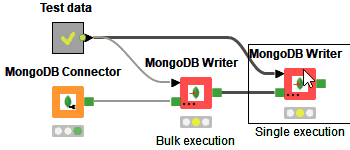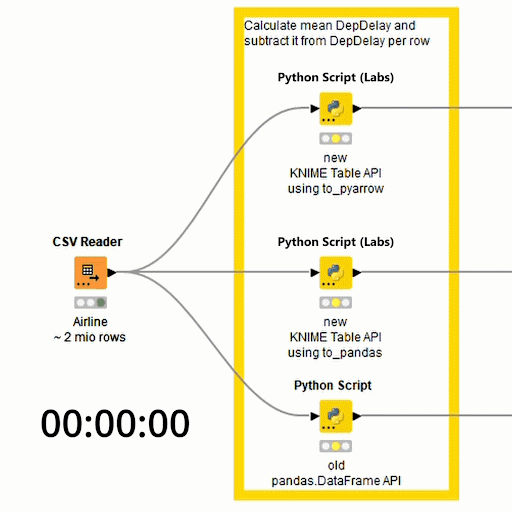What's New in KNIME Analytics Platform 4.5 and KNIME Server 4.14
Featuring better data wrangling, Python scripting, workflow deployment, and more.
Download KNIME
More Connection & Convenience
Excel Integration Improvements
New Excel Cell Updater node allows you to insert values into any cell within an existing Excel spreadsheet, while preserving the formatting.
The Excel Writer node now allows users to append data to the end of an existing sheet.
Added Connectors
Use the new Generic S3 Connector to connect to any S3 compatible file system (e.g., MinIO).
The new SharePoint Online List Reader node is available in Labs.
New connectors for standard file systems enable you to prototype workflows using a specific file system. Previously you had to update the file system in each node, but now you simply replace a single node and all file handling nodes will then use the new file system.
These include the Local File System Connector, the KNIME Workflow Data Area Connector, and the KNIME Mountpoint Connector.
Use the new Set Files/Folders Permission node to manage POSIX file permissions for file systems where it is supported, for example SSH or HDFS. The existing Files/Folders Meta Info node can now fetch POSIX file permissions.
Added Convenience
The DB Loader now also supports Amazon Redshift, so you can load millions of rows into an existing Redshift table within seconds.
The MongoDB Integration is now up to 50 times faster than the single row execution used previously. This applies to all data manipulation nodes via the option to bulk execute commands.
-
Use the new MongoDB Aggregation node to define and execute pipelines that aggregate the data within MongoDB before retrieving the data into KNIME. Download example workflow on KNIME Hub: MongoDB Aggregation Pipeline
-
With the new MongoDB Run Command node you can execute database management controls in MongoDB from within KNIME Analytics Platform. Download example workflow on KNIME Hub: MongoDB Bulk Size
-
And the new Parameter Optimization Loop Start (Table) node lets you define the hyperparameters in a separate node, so they can be fed as a table to one or several nodes. Download example workflow on KNIME Hub: Hyperparameters Optimization and Training a Random Forest
Small additions:
-
We’re continuing to migrate existing reader and writer nodes to the new framework such as XML and JSON Reader/Writer.
-
The Apache Parquet library has been updated with added support for the new type annotations as well as for Parquet’s MAP type.
New & Improved Deployment Possibilities
Workflows as a Service
Workflow Services make it much easier to call KNIME workflows from other workflows. Rather than invoking standardized (but limiting) JSON-based APIs, it’s now possible to connect directly to KNIME native API endpoints.
This means that it’s possible to share many more KNIME data types, beyond what’s possible with JSON (e.g., text documents, decision trees, deep learning models, and many more.) Workflow Services also allow you to define multiple input & output nodes (of consistent or varying data types). Efficiently call these nodes with the new Call Workflow Service node.
Download example workflows demonstrating Workflow Services to Process Anonymized Data
KNIME Edge
Data and IT teams can now provide inference workflows as a service with KNIME Edge. Applying models on the edge is a technical solution for a number of requirements, including reducing costs, minimizing latency, increasing reliability, and enabling deployment of inference services in multiple geographic regions. Learn more about use cases for KNIME Edge on our blog.
Enhanced Dynamic Data Apps
There are new re-execution capabilities in widgets that are similar to the capability previously only provided via the Refresh Button Widget node. Data teams can now be more flexible with the UX of their data apps and build in automatic re-execution upon value change in certain widgets, including:
Once the setting is applied, an icon will appear on the top right corner of the node to indicate that this setting is active.
New WebPortal Login
The WebPortal has a new login page that you can now customize to your company or team requirements.
Integrating Python & KNIME
The new Python Script Node (Labs) features a new backend that makes Python just as fast in KNIME as it is anywhere else.
The new Python API used in the new Python Script Node (Labs) offers access to tables that are larger-than-memory, by connecting to individual batches of rows either in the Apache Arrow format or as pandas DataFrame. Download a Python Script example workflow with new Python API backend from the KNIME Hub. Read more in our KNIME Python Integration documentation.
More supported Python versions in scripting nodes. We now support Python versions 3.6 to 3.9, including newer versions of pandas.
Faster Workflow Execution
Columnar Backend provides more efficient in-memory access to KNIME tables. This feature is now out of labs with further improvements to workflow execution performance.
Authentication Enhancements
The existing single sign-on support has been extended to the following services:
-
REST via the KNIME REST Client Extension
-
SAP via the SAP Reader (Theobald Software) node
-
Various databases such as MS SQL Server and PostgreSQL
We have also extended the support for Azure Active Directory (including MFA) login to the following services:
-
Microsoft SQL Server
-
Snowflake
KNIME Hub Improvements
KNIME Hub now has advanced search. It’s now easier to find the nodes and workflows with two updates to KNIME Hub:
-
Search Filtering by Tag on the search page, lets you filter the results based on one or several tags
-
As-you-type results means you can jump immediately to the page you’re looking for, without completing the query
-
Recent search enables you to quickly get back to a previous results page
Other Noteworthy Additions
-
Two new learner nodes for logistic and linear regression were added based on the Spark MLlib with automatic nominal value encoding as well as rich model statistics
-
Switch & Loop nodes now support dynamic ports, which can be configured via the context menu. As a result, nodes such as the CASE Switch Start support more port types. Loop nodes, such as Loop End, can now be customized to support multiple inputs
-
The new Model to Binary Object and Binary Object to Model nodes enable you to store machine learning models in any database that supports binary data
Release Notes
-
Encoding of paths containing '+' character has been fixed. Previously a file path such as '/tmp/foo+bar was incorrectly URL encoded ('+’ became ' '). Paths like that are considered corner cases but caused problems in the past.
-
The knime.ini has a new virtual machine argument: -Dknime.xml.disable_external_entities=true. It enables strong security when parsing XML files, such as contained in stored workflows, by ignoring all DOCTYPE declarations when parsing xml strings. It prevents XML external entity (xxe) attacks, e.g. when reading corrupted workflows. Special thanks to NATO (Dawid Czarnecki) for reporting this potential security risk.
-
The following nodes were marked as deprecated and were replaced by new nodes offering the same (and additional) functionality:
-
Parquet Reader (deprecated)
-
Counting Loop Start (deprecated)
-
Generic Loop Start (deprecated)
-
Interval Loop Start (deprecated)
-
Loop End (2 ports) (deprecated)
-
Loop End (deprecated)
-
Recursive Loop End (2 ports) (deprecated)
-
Recursive Loop End (deprecated)
-
Recursive Loop Start (2 ports) (deprecated)
-
Recursive Loop Start (deprecated)
-
Variable Condition Loop End (deprecated)
-
CASE Switch Data (End) (deprecated)
-
CASE Switch Data (Start) (deprecated)
-
CASE Switch Model (End) (deprecated)
-
CASE Switch Model (Start) (deprecated)
-
CASE Switch Variable (End) (deprecated)
-
CASE Switch Variable (Start) (deprecated)
-
-
The node PPilot Connector was marked as deprecated without replacement. Users are asked to use the service’s REST interface along with KNIME’s REST client nodes in the future.
Download KNIME
Download the latest version of KNIME and try out the new release features.








